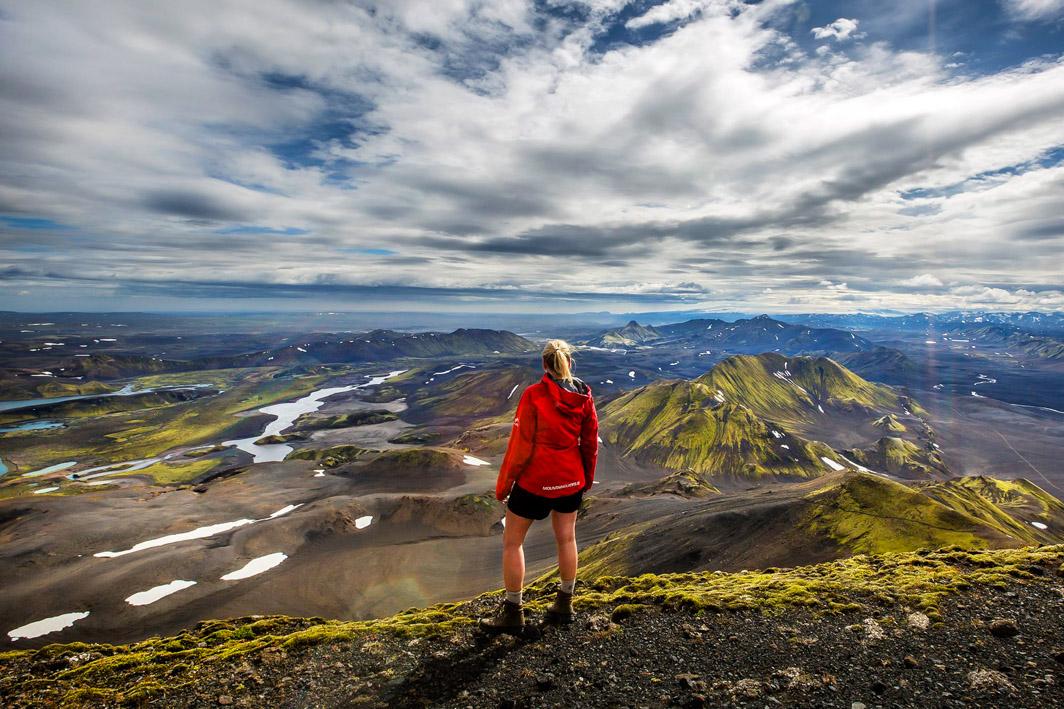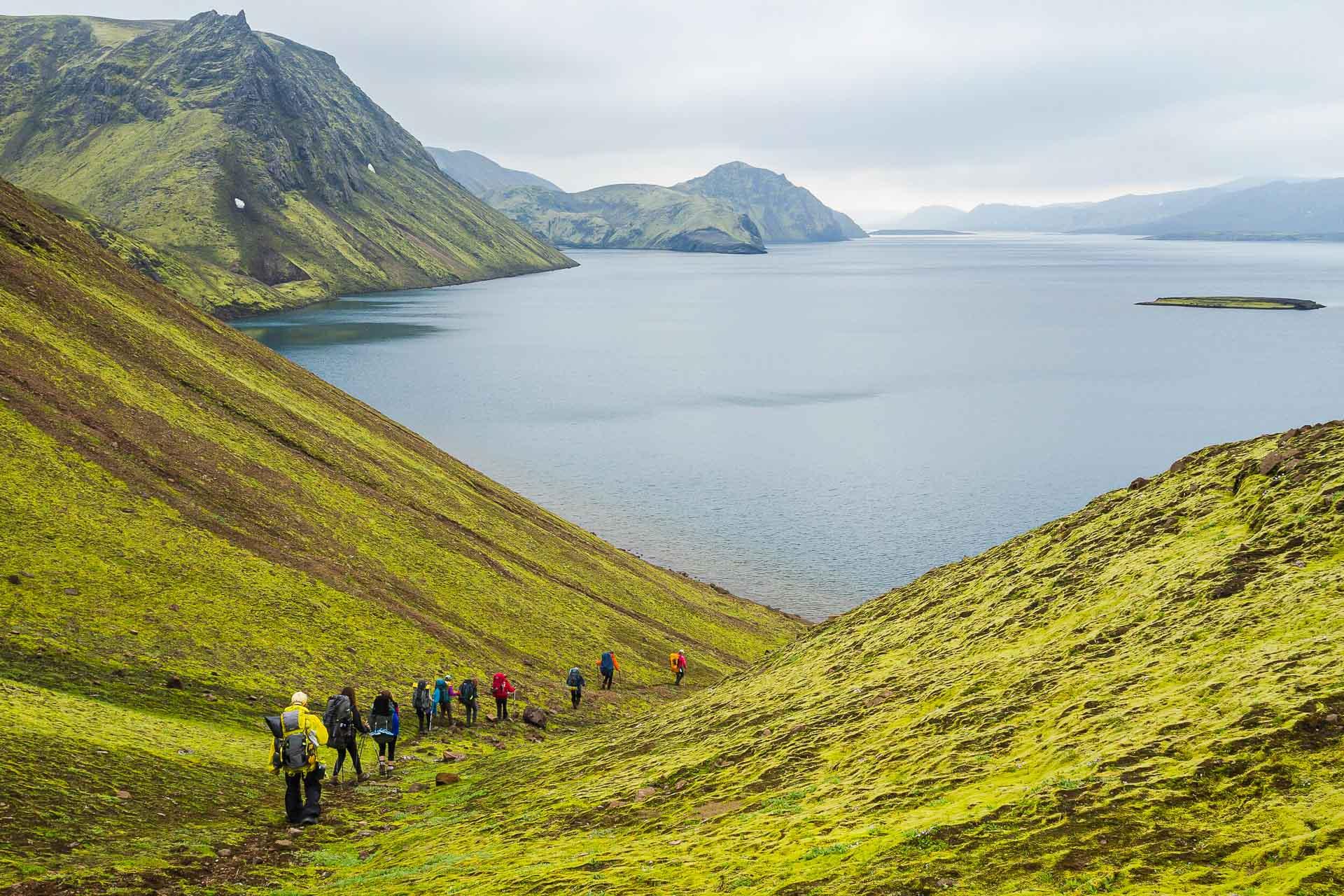A Complete Guide to Solo Hiking in Iceland
| All, Travel Guide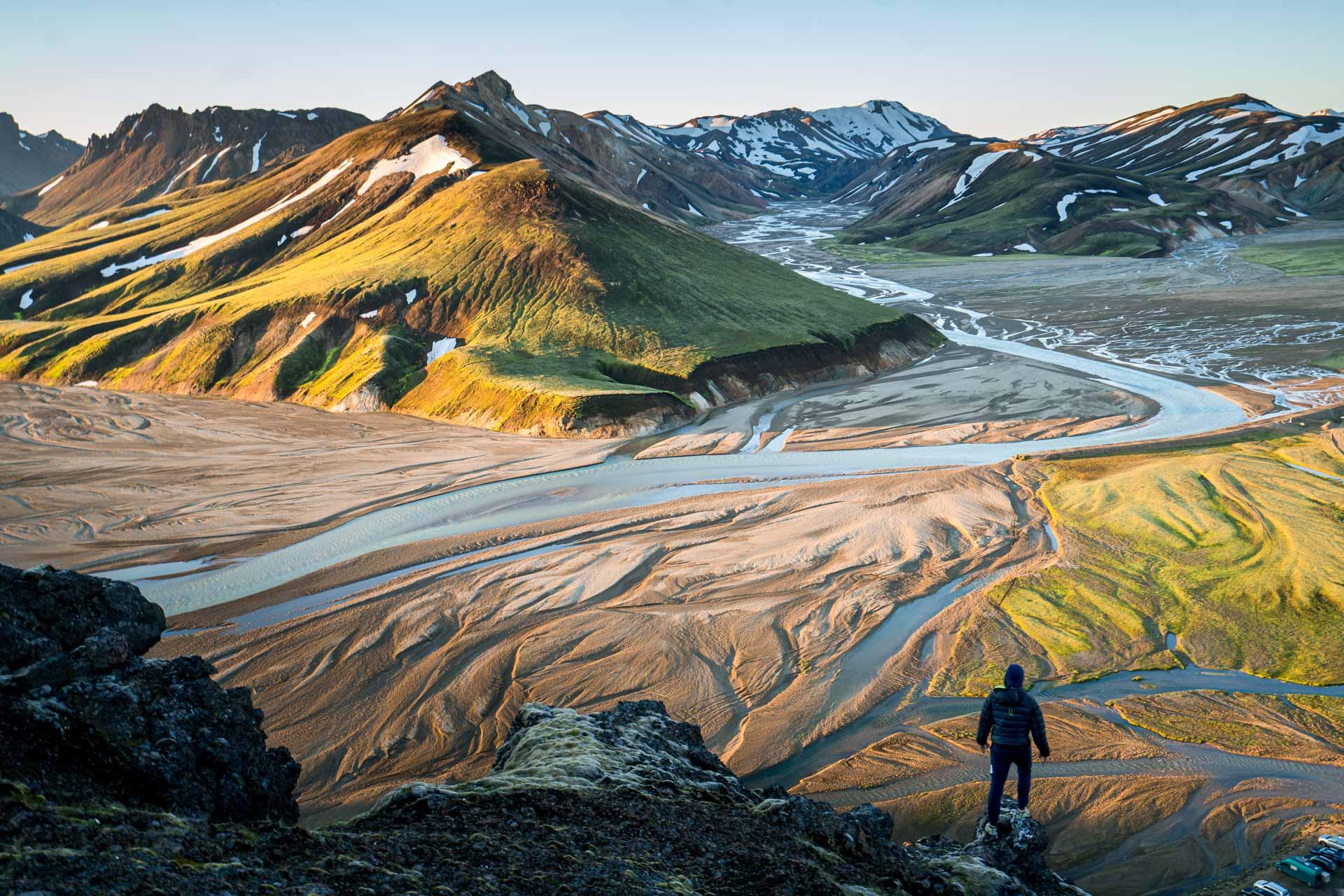
Table of Contents
There’s something special about hiking on your own. There’s just you and the wilderness and the wildlife around you. In the solitude of the Icelandic Highlands or in the Westfjords, you might glimpse a herd of deer grazing on a distant hillside or an Arctic fox bound across a track. You might see a sea eagle circling above you on a coastal path.
Walking in silence, you’re more likely to chance on wildlife, and with no one else around to distract you, you’ll be more in tune with the great glacial and volcanic landscapes of Iceland. Your only communication will be with nature. You’ll feel more connected to the natural world you’re walking through. Solo hiking teaches you to be more present, enhancing your sense of wellbeing.
When you’re on your own, there’s no one else to depend on: you have to draw on all your inner strength and become truly independent. You develop survival and hiking skills. You learn how to assess risk and make decisions by yourself. You discover how to be at ease with your own thoughts. Practically, you can hike at your own pace and stop when you like.
Solo hike Iceland and discover how magical it is to be alone, just you and the wilderness.

Why Iceland is the best place to hike alone
- Iceland has some of the best hiking in the world, and there are many reasons to hike there alone.
- There are long daylight hours between June and August when solo hiking is recommended.
- There are no dangerous animals to worry about. Neither do you have to contend with biting insects, ticks or mosquitoes.
- Iceland is ranked the safest country in the world year after year.
- There are hardly any forests to get lost in, and not even much in the way of low-lying shrubs. (You may have heard the Icelandic joke: What do you do if you get lost in a forest? Answer: stand up). Open views and good conditions help significantly in navigating the land.
- The water is clean, and plenty of it (but do check your route).
- You’ll find some of the world's most diverse, otherworldly and majestic landscapes: we confidently make that claim!
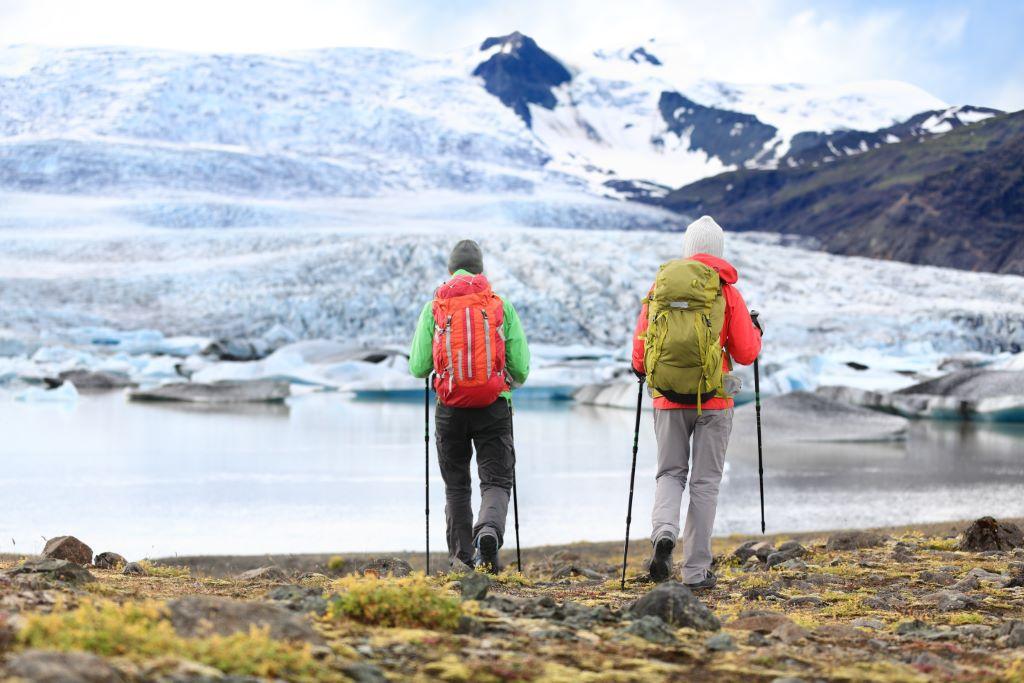
The Ultimate Guide to Hiking in Iceland
The comprehensive guide to hiking in Iceland tells you everything you need to know: where the scenery is at its most spectacular; when to go and how to prepare; the best hikes in Iceland, including distance, the time needed to complete the walk, height gained and tours you can take with Icelandic Mountain Guides.
Cons of hiking in Iceland alone
Hiking is tough on high ground, but the rewards for anyone who loves wide open spaces and pure wilderness far outweigh any disadvantages. If you’re new to hiking, you’ll need to be aware of the downside to hiking in Iceland:
- The weather is chilly, and often rainy and windy and can change quickly without warning, even in summer.
- Your backpack will be heavier as you’ll need a spare set of dry clothing to keep you warm in challenging conditions.
- Some paths are not well trodden, and often they’ll not be well marked either. As there are, by and large, no trees in the Icelandic Highlands, wind can move guiding stones or poles.
- Terrain can be rough and difficult to negotiate due to sharp volcanic rocks, loose scree, tricky edges and steep gradients. You’ll need hiking experience for these demanding high-level treks.
- The need to ford rivers is not uncommon in Iceland and can be even more challenging when walking alone. Hiking poles are essential, and you may need a change of shoes.
- Network coverage is not available everywhere in the mountains. You’ll require survival know-how.
If you’re unsure about solo hiking or inexperienced, the safest option is to join a guided tour! Icelandic Mountain Guides offer thrilling hikes for all abilities with the security of a guide. Alternatively, you can book a self-guided hike with Icelandic Mountain Guides, who will support you with all the logistics.
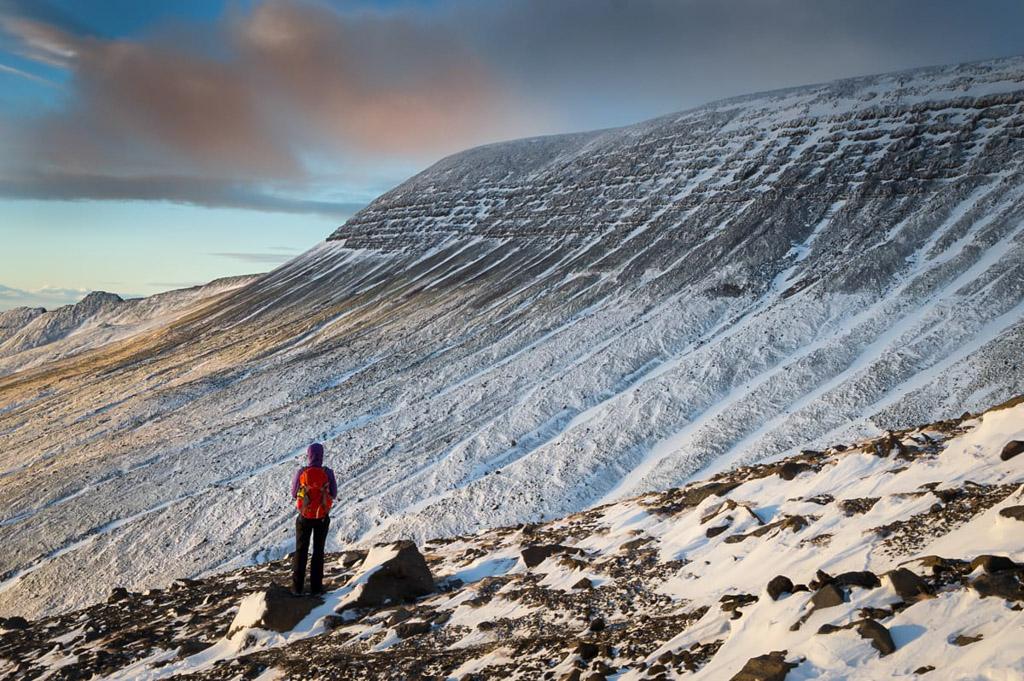
Mount Esja in winter
Solo Hiking Essentials in Iceland
If you’re hiking solo in Iceland, there are some basic requirements you need to be aware of:
- You need experience walking on high-level ground, sometimes through tricky and challenging terrain.
- You need high-quality gear. This includes outdoor clothing that will protect you in wet, windy and sometimes snowy conditions. You need a hard-wearing backpack, strong ankle-supporting and waterproof hiking boots, a hat, warm gloves, and socks to protect the extremities.
- Dry Bags are crucial for keeping your keys, mobile phone and other valuables dry, as well as spare clothes.
- Take a charged phone with the relevant maps downloaded- but don’t depend on your phone, as you won’t always get a signal. You’ll need the backup of a GPS beacon, compass AND a physical map. Make sure you know how to use them.
- Never set out alone without leaving your hiking plan with others. Iceland has an excellent Safe Travel app where you can submit your travel plan.
- Your travel plan should include the distance you plan to hike, any accommodation details and contingency plans.
- The route plan should be left with a trustworthy person with precise information about your trip.
- Ensure you have researched your route thoroughly: Is it suitable for your experience and fitness level? Is it open? Do you have all the information you require to hand in? What equipment do you need for the route you’ve chosen? Do you need specialist climbing equipment or overnight camping gear?
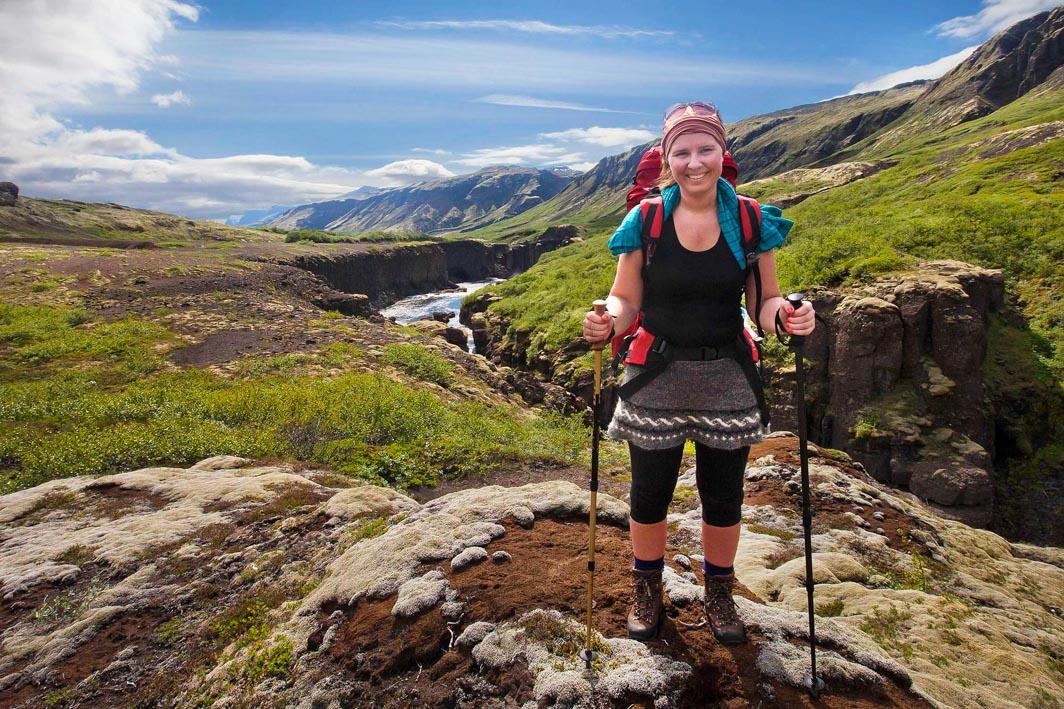
A solo female hiker
Tips for Solo hikers in Iceland
- You don’t want to be weighed down by an unnecessarily heavy backpack that will hinder your progress or cause back problems. Pack as light as possible, but ensure you have everything you need for your trip, heavy items at the bottom.
- Always have an extra set of warm clothing protected in a drybag
- It’s always safer to pick a well-travelled, well-marked trail when hiking solo.
- Know your limits. You don’t want to be caught in isolated uplands far from the nearest road because you’re exhausted or underestimated your ability to negotiate challenging terrain.
- Be aware that mists can descend suddenly, greatly reducing visibility. Knowledge of map and compass reading is crucial if hiking alone.
- Be realistic about how far you can hike in an hour, bearing in mind rugged terrain that will slow you down, and plan accordingly.
- Safetravel.is offers excellent advice on safe hiking on their website.
- The Icelandic Mountain Guides website is packed with helpful information on preparing for hiking in Iceland. Pick up useful tips from our blogs.
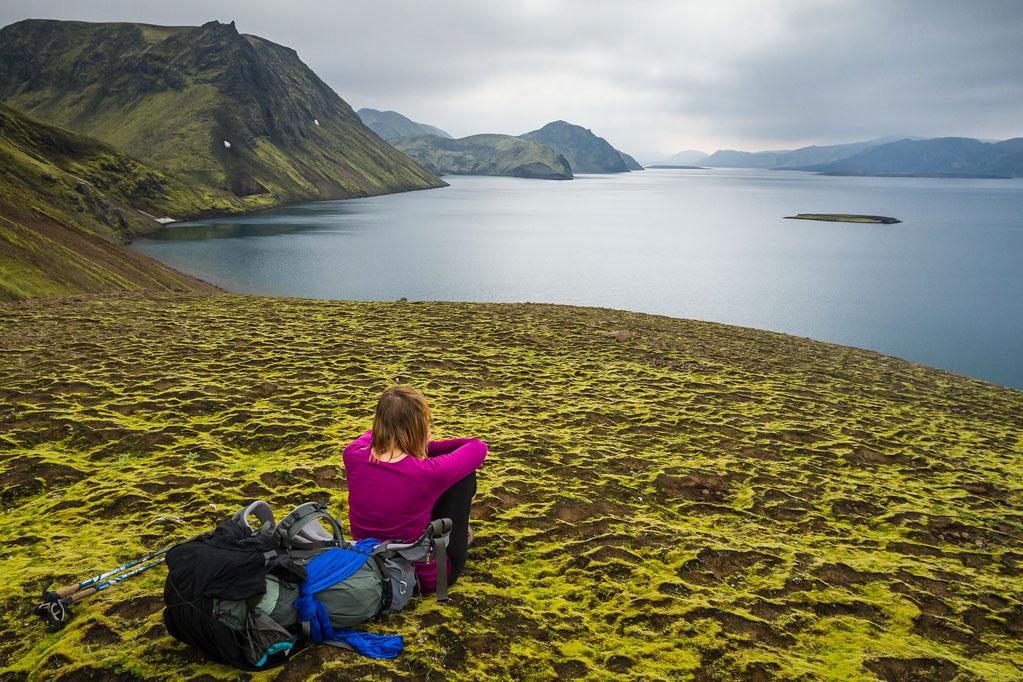
How to stay safe while hiking alone in Iceland
- Plan the hike and let someone know the plan. Use the safetravel.is app.
- Always stay on the trail.
- Be prepared for sudden weather changes, and check the daily weather forecast with the ranger or warden before you start your hike each day.
- Stick with the travel plan you shared.
- Always write your name and the date in guest books at your accommodation for safety reasons.
- You can pick up a Personal Location Beacon (PLB) (also called an emergency beacon) from safetravel.is. The radio transmitter can be activated in an emergency if you need help.
- Some routes require you to ford a stream or even a wider glacial outlet river. Reading the landscape - in this case, the river - to find the best place to cross is a good skill to have. Look for meanders in the river and for places where the flow is gentle, and water levels are low. There are some top tips on fording rivers with safetravel.is.

The Ultimate List of the Best Hikes in Iceland
So, you’re confident you have the experience and ability to go solo. But where to start? This comprehensive guide to hiking in Iceland gives you the lowdown of some of the most exciting hikes in Iceland, from easy to demanding and everything in between. Check out Icelandic Mountain Guides summit, valley, coastal and glacier hikes covering the whole island: Icelandic Highlands, Vatnajökull National Park, South, East and West Iceland, and hikes easily accessed from Reykjavik.
Camping, glamping and staying in huts
Overnight options vary significantly in the wilderness areas of Iceland. Campsites may offer the full range of camping facilities, including hot-water showers and electricity, or they may have next to none: bringing a quality power bank with you to charge your phone is a good idea. Mountain huts are the same: they may have hot running water on tap but may also only provide cold running water with the possibility of heating water from a large pan on the cooker!
They may even bring in containers of water for use in very basic kitchens. Sometimes you’ll have to fetch water from a stream. With the exception of the Laugavegur hiking trail, there’s no opportunity to buy supplies along the trails: you’ll need to bring your own. Often there’s no internet access or phone signal. Some huts will have flush toilets, others just a latrine. It’s part of the mountain experience - and thinking positively - part of the adventure. Creating headspace away from the modern interconnected world can also be good.
If you are doing multi-day hikes, you can check out the forty mountain huts owned by Ferðafélag Íslands, the Iceland Touring Association - FÍ. Note the huts will be closed in the winter season along with the roads approaching them.
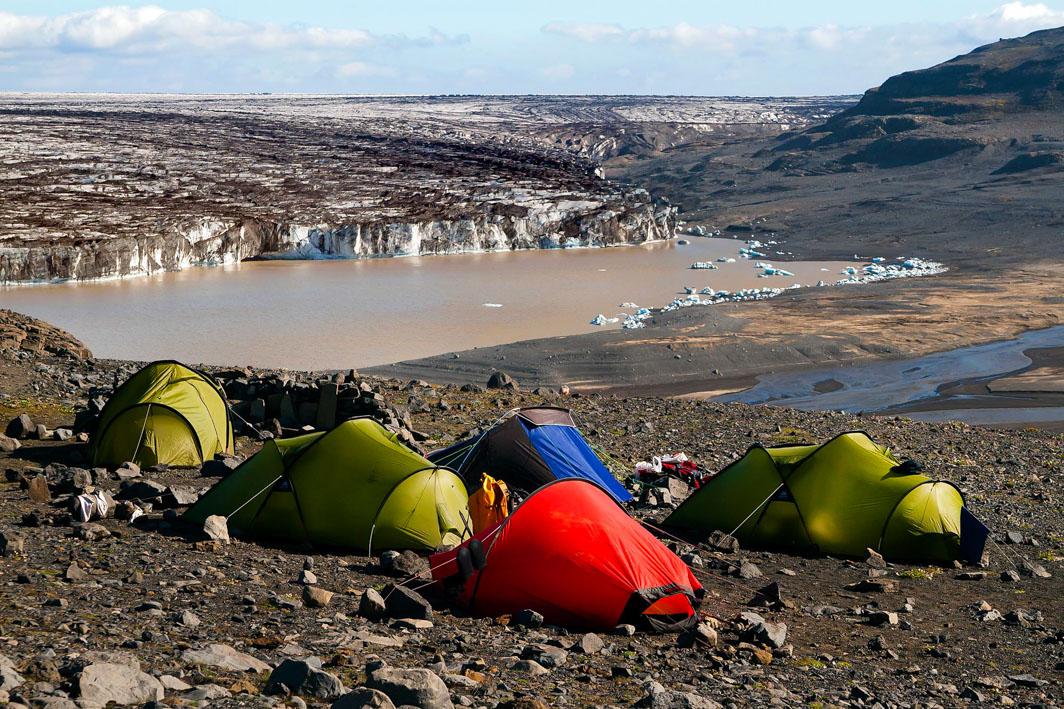
We pitch our tents during our guided wilderness treks with the permission of the authorities
Huts on the Laugavegur Trail
The trail, meandering through some of Iceland’s most stunning scenery, is accessible and served by an excellent hut system its entire length. Consequently, it’s very popular and you’ll need to book your accommodation well in advance. As the huts are off-grid, they are basic to say the least.
There’s no electricity but the huts are heated geo-thermally or with gas. The kitchens have gas cookers and cooking equipment. Sleeping accommodation consists of communal bunk rooms - or even just mattresses placed on the floor. You’ll need to bring your own sleeping bag and pillow. Most huts offer warm showers (for a fee). All the information you’ll require can be found in the Laugavegur Huts and Accommodation Guide.
Huts on the Volcano Trails
For those who prefer to have some creature comforts, there’s an opportunity to do some glamping in a furnished tent at Þórsmörk. Each tent contains a proper bed with a warm down duvet, heating, chairs and table, while a restaurant, sauna and pool, shared toilets and showers are all close by.
If you prefer four solid walls, the Eyjafjallajökull Cabin Rooms and Sheepherders Cottages provide even more comfort. The Katla Hut Accommodation has access to WiFi, showers, sauna and a sitting pool. Find out more about Accommodation on the Volcano Trails.
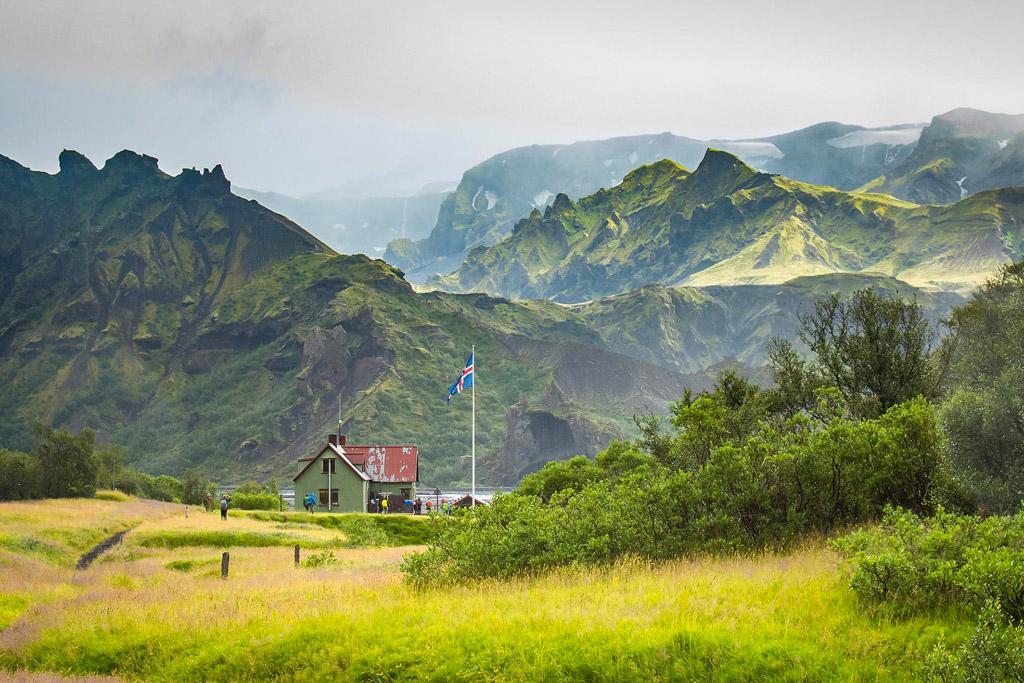
Mountain hut in Thórsmörk
Wild camping in Iceland - Is it Allowed?
It’s a misconception that you’re allowed to camp anywhere in Iceland. While there are still places where wild camping is permitted for hikers, the regulations are strict. Wild camping is only allowed in tents for hikers in areas that are:
- not on private property,
- not on cultivated land
- not in a national park or nature reserve
- not within 5 km of the nearest town or a campsite.
If you are planning to wild camp in Iceland, please make sure you are fully aware of where you can wild camp and what your obligations are. Flora in the highlands can be very delicate and easily damaged. Research the official campsites and where you can’t wild camp, including national parks and nature reserves. Join the Hiking in Iceland Q & A Facebook page, where you can raise any queries.
Is it safe for women to hike solo?
In a country with an excellent safety record, low crime rates and high regard for women in Icelandic society, the answer is yes. It’s not uncommon for women to hike solo in Iceland.
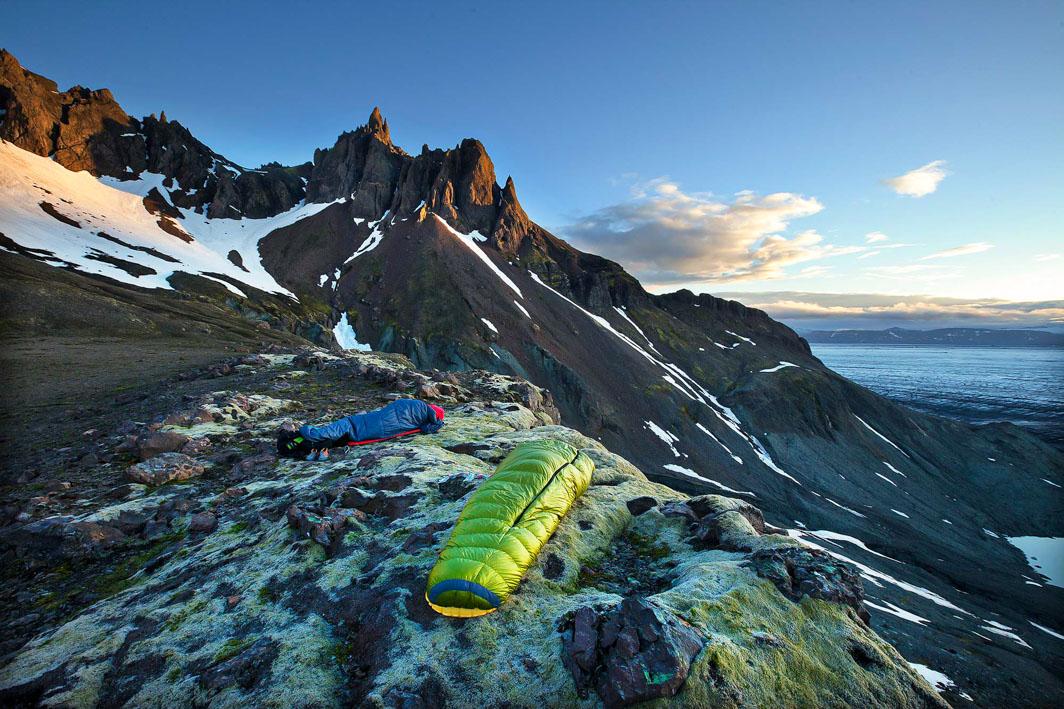
Bivouacking is allowed in the wilderness
The Highland Bus
Have you ever seen a bus cross a fast-flowing river? This Instagram video went viral when a Reykjavik Excursion bus driver drove through higher-than-usual water with superb confidence and skill. The highland bus drivers have to navigate some challenging terrain, and, as you see from the video, they’re more than up to the job!
Many of the highland trails start out from difficult places to access and cannot be reached by the average cars built for paved roads. Even if you have a high clearance 4WD, you’ll need the skills to navigate unpaved roads and dirt tracks with the occasional river crossing thrown in for good measure. And, trekking a linear route, you have to figure out how to get back to your car at the starting point!
It makes sense to buy a ticket for the highland bus, climb aboard, sit back and enjoy the scenery. The drive in is an adventure in itself. Here are three starting (or finishing points) for some of Iceland’s best-loved trails, Reykjavik Excursions highland buses putting you down or picking you up at your chosen trail’s beginning and end.
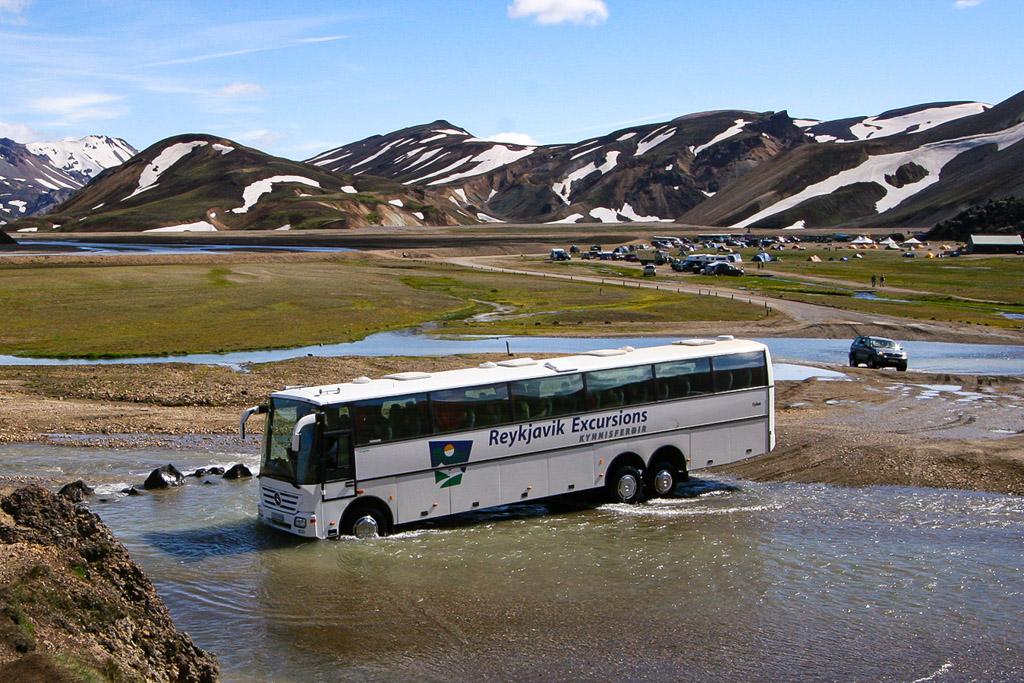
The epic Highland Bus crosses the river before reaching Landmannalaugar
Skógar and the Fimmvörðuháls Hiking Trail
A green oasis, Skógar sits under the majestic Eyjafjöll mountains, a stunning starting point for an Icelandic solo hike. The drive in takes you past pretty farms and settlements, passing waterfalls, mountains and volcanoes. The 20 km, 1-2 day-long Fimmvörðuháls Hiking Trail between Skógar and Þórsmörk takes in superb glacial landscapes and the magnificent Skógafoss waterfall.
Landmannalaugar and the Laugavegur Trail
The highland bus has a daily service to Landmannalaugar from Reykjavik, whether you're starting or finishing the superb Laugavegur Trail from there. The classic trek is one to add to your bucket list: classified by National Geographic as one of the 20 best treks in the world.
The fields of Þórsmörk: two trails
Meaning ‘Thor’s field or forest’, Þórsmörk is a green oasis surrounded by glaciers and mountains. It’s a fabulous starting or finishing point for two of Iceland’s most popular hiking trails: Laugavegur (to Landmannalaugar) and Fimmvörðuháls (to Skógar). Step onboard and take your pick.
With dirt tracks and gravel roads leading to the trails, Reykjavik Excursions operate specialised highland buses with trained drivers who know how to navigate challenging routes safely. The highland bus runs daily in summer between the capital and Skógar, Landmannalaugar and Þórsmörk.
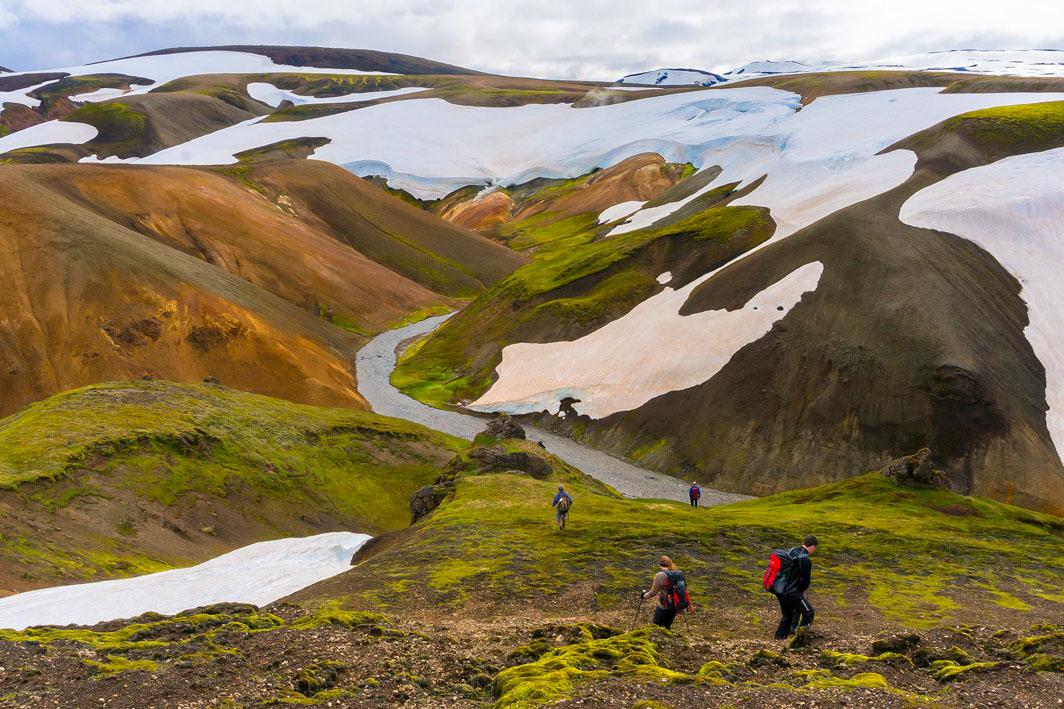
Landscape on the Laugavegur trail
Packing list for a solo hike in Iceland
It all depends if you are doing a day hike or a multi-day hike, where you’re hiking and whether you have no choice but to wild camp in places. Solo hiking should only take place in the summer months.
Summer multi-day hiking
- Backpack: personal hygiene items; first-aid kit; sunglasses and sunscreen
- Navigation aids: personal location beacon; mobile phone; compass; paper map; GPS; extra batteries; power bank
- Sleeping: three-season tent and mattress (if you tent camp); sleeping bag; inflatable pillow
- Cooking: portable gas cooker; cooking equipment and utensils; cutlery and dishes; penknife; matches (if you need to wild camp) and food, of course!
- Clothing: breathable base, middle and outer layers (waterproof and windproof); hat, buff; gloves and waterproof boots; shoes for river crossing. For more clothing tips, see our article about What to wear on a glacier hike in Iceland.

What to Wear on a Glacier Hike in Iceland
For glacier hiking, you’ll need to dress as you’d hike elsewhere. Sunscreen and sunglasses are essential on the ice. Guides will provide any other equipment required, such as crampons, ice axes, harnesses and helmets. Check out our comprehensive list of what to wear on a glacier hike in Iceland.
At a glance - your questions answered
Is it safe to hike in Iceland alone?
One of the safest countries in the world, you can safely hike in Iceland alone. In terms of weather, walking conditions and injury, you’ll need to take all that into consideration. Do everything you can to prepare yourself against risk.
Is Iceland good for solo Travellers?
Yes, with great hiking infrastructure and comprehensive information on the main trails, along with the excellent safetravel.is app, you can solo hike with confidence.
How do you stay safe when solo hiking?
Make sure you know your fitness and stamina levels, choose a suitable route, plan thoroughly and take good-quality equipment. Make sure you have physical and electronic maps along with a compass - and know how to use them.
Is it safe to hike alone at night in Iceland?
In daylight it’s not a problem, and with daylight hours extending towards midnight in summer you can hike for long hours. It’s a magical experience.
What is the #1 etiquette rule while hiking?
Simple: pick up all your rubbish; leave no trace.
Is it illegal to sleep in a campervan or car in Iceland?
You are not allowed to ‘wild camp’ in a vehicle in Iceland: you must stay overnight in a designated campsite.
Is there free camping in Iceland?
The short answer is no, but camping is still a good budget choice.
Can you wild camp in Iceland?
Outside private land, cultivated land, national parks and nature reserves, you can wild camp if you’re hiking when there’s no official campsite in the vicinity.
Is hiking in Iceland free?
There’s no fee in national parks, but you’ll need to pay for transport, parking, food, campsites, huts and guided tours.
Can you hike on a glacier in Iceland on your own?
Never. It’s dangerous and not permitted. Book a guided tour and enjoy an amazing experience safely.
So why are you waiting? Step out on your own, solo hike Iceland, drink in the magnificent landscapes of Iceland’s best-loved trails without any distractions, feel at one with nature, thrill at the solitude of the vast wilderness and congratulate yourself at the end of a thrilling hike for making it independently.
Keep me informed about the Icelandic Mountain Guides Blog
Outdoor adventure in Iceland is our specialty. Subscribe to our free monthly newsletter to learn when to go, what to do and where to have the best adventures in Iceland.
Related Blog Posts
Related Tours
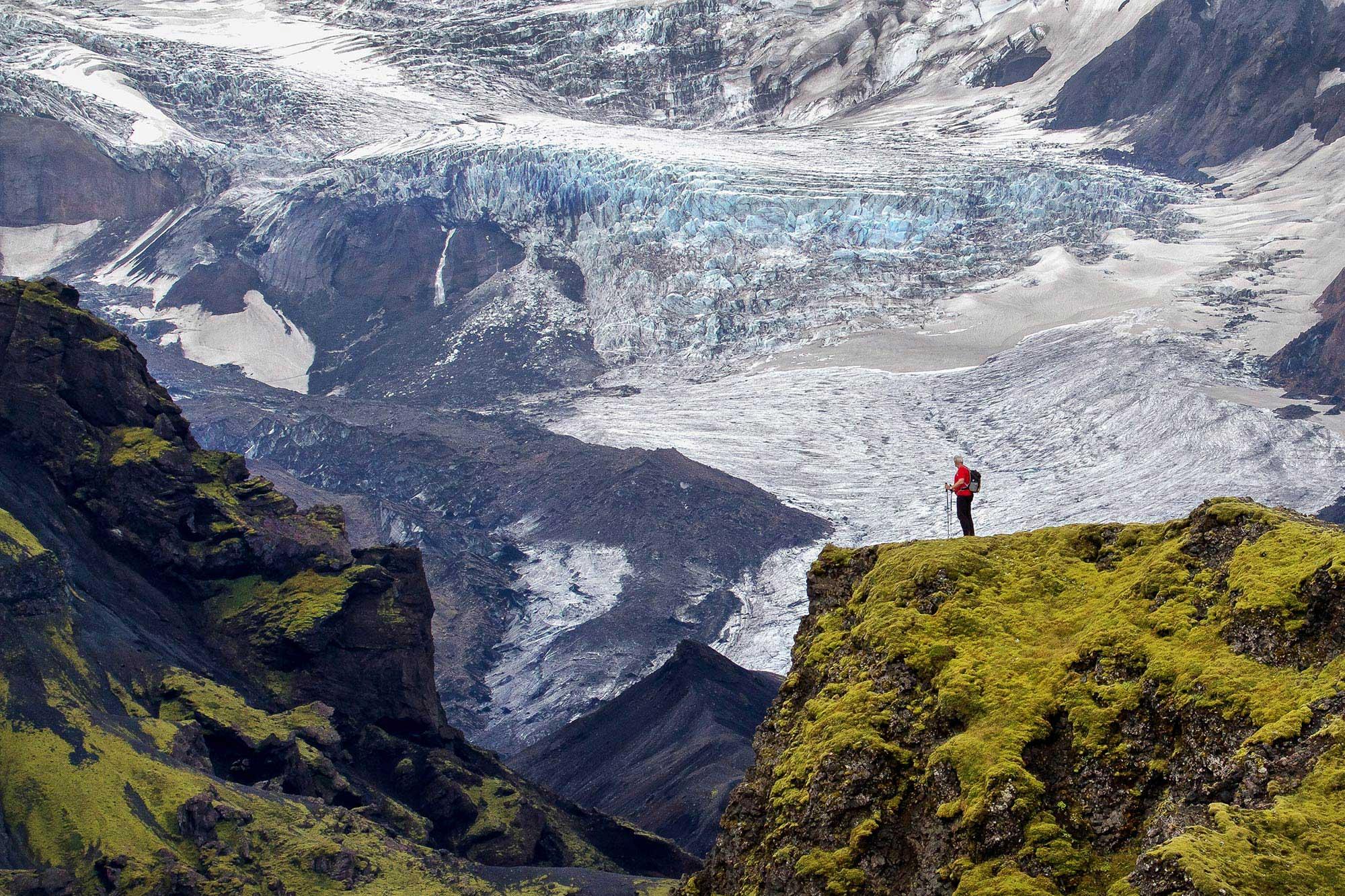
Laugavegur & Fimmvörðuháls Combo Tour
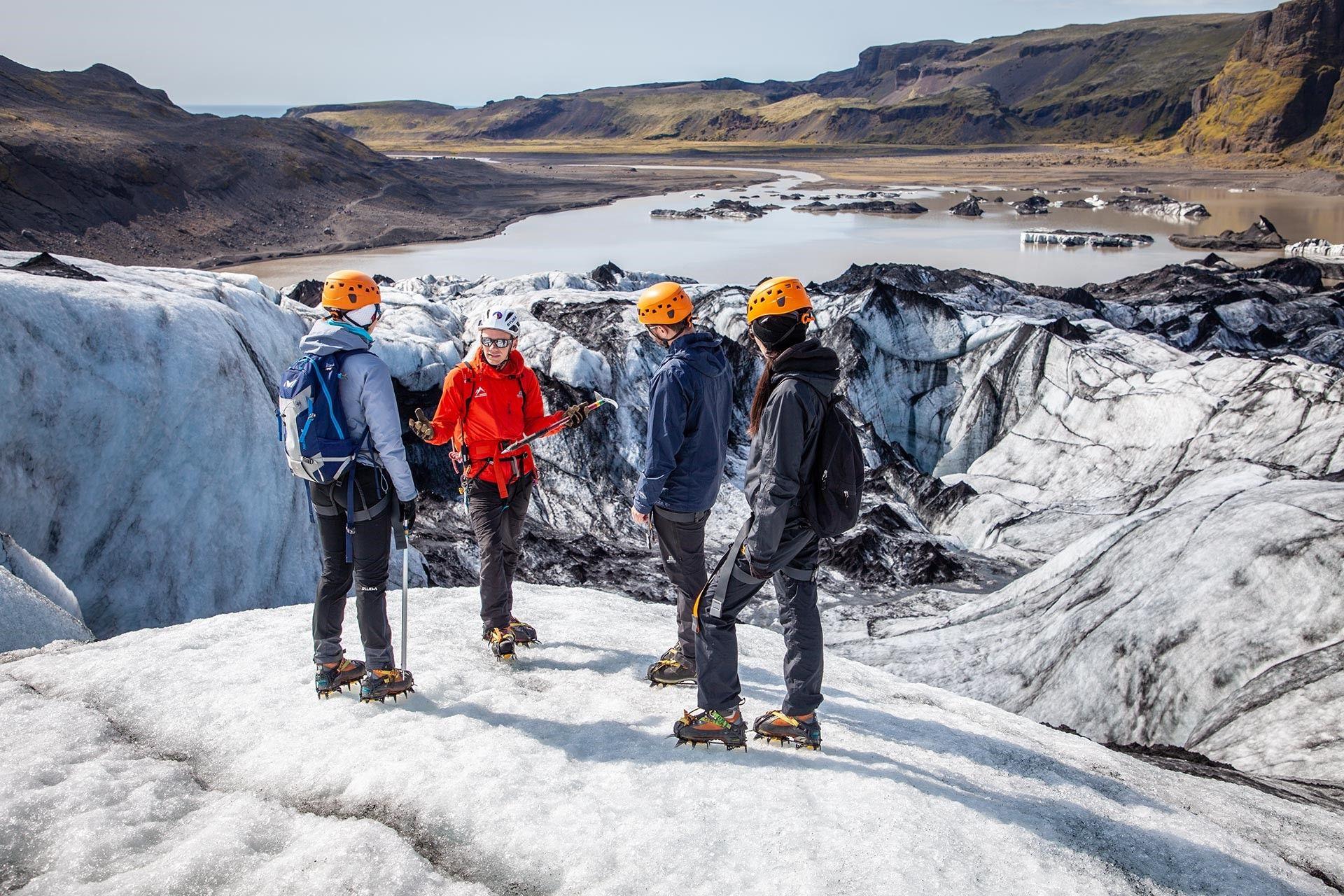
Glacier Discovery - 3-hour Sólheimajökull Glacier Hike

Laugavegur Trail - Self Guided


